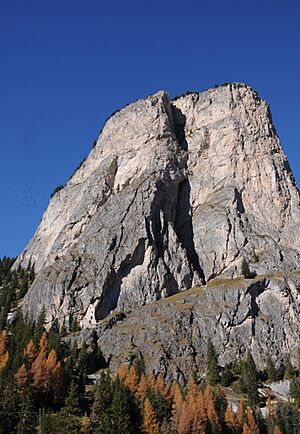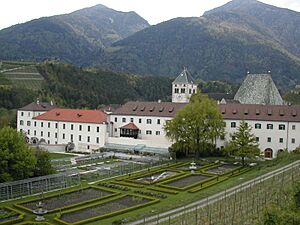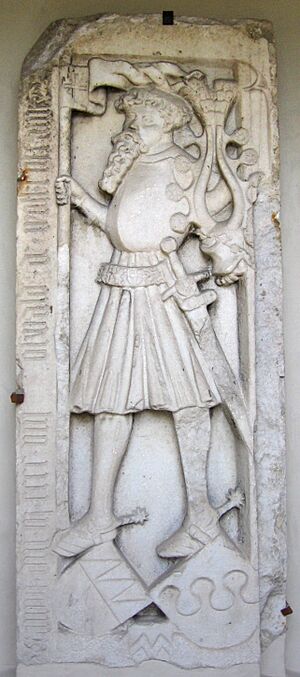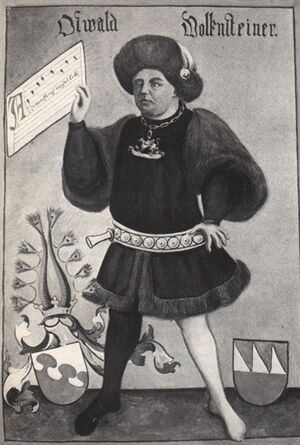Oswald von Wolkenstein facts for kids
Quick facts for kids
Oswald von Wolkenstein
|
|
|---|---|
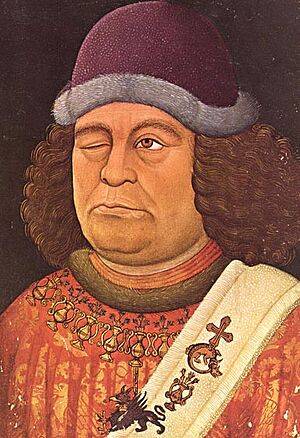
Oswald von Wolkenstein - Portrait from the Innsbrucker Handschrift, 1432
|
|
| Born | 1376 or 1377 Pfalzen
|
| Died | August 2, 1445 |
Oswald von Wolkenstein (born 1376 or 1377 in Pfalzen – died August 2, 1445, in Meran) was a famous poet, composer, and diplomat from the Middle Ages. He traveled a lot across Europe, even reaching as far as Georgia. He wrote about his adventures in his songs.
Oswald was honored as a Knight of the Holy Sepulchre, which meant he had visited the Holy Land. He also joined two special groups of knights: the Order of the Jar and the Order of the Dragon. For a while, he lived in Seis am Schlern.
Oswald's Amazing Life Story
Early Adventures and Journeys
Oswald's father was Friedrich von Wolkenstein, and his mother was Katharina von Villanders. When Oswald was just ten years old, he left his family. He became a squire, which is like an assistant to a knight errant (a knight who travels looking for adventures).
Oswald wrote about his travels over the next 14 years in his song "Es fügt sich..." (meaning "It happened..."). He visited many places, including Crete, Prussia, Lithuania, Crimea, Turkey, the Holy Land, France, Northern Italy, and Spain. He even survived a shipwreck in the Black Sea!
Returning Home and Family Troubles
After his father died in 1399, Oswald returned to the County of Tyrol. He soon started arguing with his older brother, Michael, about their family's inheritance.
From 1401 to 1402, Oswald joined King Rupert of Germany on a trip to Italy, but it wasn't successful. In 1407, he and his brother finally agreed to split their inheritance. Oswald received a part of Castle Hauenstein and its lands in Seis am Schlern. However, Oswald didn't respect the agreement and took over the entire castle, even parts that belonged to another knight, Martin Jäger.
In 1408, before going on a pilgrimage to the Holy Land, Oswald had a memorial stone placed on the wall of the cathedral in Brixen. This stone is still there today and shows him dressed like a Crusader with a long beard, which was common for pilgrims. Before leaving, he wrote songs for Anna Hausmann, a woman he admired. After returning in 1410, he was allowed to live at Neustift Monastery, a religious house near Brixen.
A Diplomat for the Emperor
In 1414, Oswald joined the group of Duke Friedrich IV of Austria at the Council of Constance. This was a very important meeting of church and political leaders. A picture of Oswald can be found in the council's historical record.
Oswald then became a diplomat for Emperor Sigismund, who was also King of Hungary. His first diplomatic journey took him to England, Scotland, and Portugal. He even took part in the capture of the city of Ceuta from the Moors (Muslims) in North Africa. In 1416, he traveled with King Sigismund to France and then back to Constance.
Marriage and Conflicts in Tyrol
In 1417, Oswald married Margarete von Schwangau, and they had seven children together. Later that year, he went back to Tyrol. He joined a group of nobles called the Elefantenbund (Elephant Alliance). This group was against Duke Friedrich IV, who had been punished by King Sigismund for helping a church leader escape.
Duke Friedrich IV, with the help of local people, especially farmers, managed to fight off the King and the nobles. From 1418 onwards, Friedrich strongly pursued his enemies in Tyrol. In September 1421, Oswald was tricked by Anna Hausmann and captured by Martin Jäger. Jäger took Oswald to Innsbruck and handed him over to Duke Friedrich.
In March 1422, Friedrich released Oswald for five months. Oswald had to promise to pay 6,000 ducats (a type of gold coin) and swear not to seek revenge. He was supposed to settle his debts with Martin Jäger and other nobles. However, Oswald couldn't reach an agreement. Instead of returning to Tirol Castle, he rode to Hungary to meet King Sigismund. Together, they planned a war against Duke Friedrich. Oswald's brother Michael started the war by writing to Friedrich on September 5, 1422, saying he would be his enemy.
In 1423, the fighting became serious. Oswald and his two brothers were inside Castle Greifenstein when it was under attack. They successfully fought back in November 1423. However, because the people of Tyrol and the bishop of Brixen supported Duke Friedrich, most nobles, including Oswald's brothers, gave up on December 17, 1423. Oswald was one of the last nobles to surrender.
Peace and New Beginnings
Things became calmer in 1424. Oswald asked the Neustift Monastery to create a book of his songs. This peace was partly because King Sigismund had too many wars to fight at once. On February 17, 1425, the King and Duke Friedrich made peace at Castle Hornstein, and Oswald was there.
Oswald returned to Tyrol with no money. Duke Friedrich still wanted the 6,000 ducats. Oswald tried to get the money but couldn't, so he fled Tyrol. In 1425, he stayed at Castle Neuhaus near Gais, which was not part of Tyrol at that time. Friedrich immediately started attacking Castle Greifenstein again.
After Wilhelm von Starkenberg surrendered in November 1426, Oswald was the last noble still fighting Duke Friedrich. He was called to a meeting of nobles in Bolzano. Oswald fled Tyrol again, but he was caught near Wasserburg on Lake Constance. He was brought back to Tyrol and put in prison at Castle Vellenberg in Innsbruck.
Oswald had no choice but to make peace with Duke Friedrich. Friedrich made him pay Martin Jäger for the stolen goods. In return, Oswald gained full ownership of Castle Hauenstein. Oswald also had to promise not to contact nobles outside Tyrol unless Duke Friedrich allowed it.
More Disputes and the Order of the Dragon
In 1428, Oswald broke his promise and traveled to Heidelberg. He wanted help from a group called the League of the Holy Court in a dispute with his cousin, Hans von Villanders, who owed him 2,200 ducats. While there, Oswald got involved in a fight between the church leaders of Brixen and the new Prince-Bishop, Ulrich Putsch. Bishop Ulrich was a friend of Martin Jäger and close to Duke Friedrich.
The conflict led to a takeover on October 30, 1429. Oswald, supported by Friedrich, led an attack against the bishop. The bishop was captured and even beaten publicly by Oswald. At first, King Sigismund supported Oswald, but after hearing the other side, both Sigismund and Friedrich changed their minds and put Bishop Ulrich back in charge.
In 1430, King Sigismund called the nobles of the Holy Roman Empire to a big meeting in Nuremberg. Oswald and his brother Michael immediately left Tyrol to meet the King. In Nuremberg, Oswald became a high-ranking member of the Order of the Dragon. This was a great honor given to only about two dozen nobles by King Sigismund.
With this honor came the duty to join Sigismund's difficult military trip against the Hussites in Bohemia in 1431. Oswald saw firsthand the huge Imperial army, about 130,000 strong, panic and run away on August 14, 1431. The entire army fled when they saw the 50,000-strong Hussite army approaching and singing.
Later Life and Final Years
Sigismund sent Oswald back to Tyrol to prepare the area for a possible Hussite invasion. Sigismund himself went to Milan and later to Piacenza, saying he needed to be crowned emperor in Rome. During this time, Oswald asked the Neustift Monastery to create a second book of his songs. Sigismund called Oswald to join him in Piacenza, and Oswald went. His unpleasant visit there inspired him to write the complaint song "Wer die ougen vil verschüren." In May of that year, Oswald was sent by Sigismund to Basel. After more than a year of talks, Sigismund was crowned Holy Roman Emperor on May 31, 1433. Oswald was likely there for this important event.
In the following years, Oswald's life became much calmer. There are almost no records of fights or trials. This changed when Duke Friedrich died on June 24, 1439. His heir, Sigismund, was only twelve years old. So, a guardian had to be chosen until Sigismund was old enough. The nobles of Tyrol chose Sigismund's uncle, Friedrich V, Duke of Austria. Oswald was put in charge of the guardianship contracts. Oswald used this chance to get help from Friedrich V with a legal dispute he had with his cousin, Hans von Villanders, which had lasted eighteen years.
When Sigismund's guardianship was supposed to end on July 25, 1443, Friedrich, who was now King Friedrich III, decided to extend it for another six years. The nobles of Tyrol started an open revolt. Oswald became one of five military commanders. He was given the important task of defending the Mühlbacher Klause (Mühlbach fortress). This fortress blocked the most likely invasion route from Styria, where King Friedrich was living. The cities of Merano and Bolzano provided money and soldiers to strengthen the fortress. All other mountain passes into Tyrol were also blocked.
Since the city of Trento supported the King, an army of 3,000 men was sent south to attack the city. On December 10, a group from Tyrol went to Graz to demand that Sigismund be released and that the county's treasures, taken by Friedrich in 1440, be returned. Friedrich refused and threatened war. The Tyroleans responded by attacking Trento and electing Johann Röttel as the new bishop on January 4, 1440. Röttel immediately declared his full support for the nobles against the King. Oswald was one of the people who chose Röttel and was the main person behind this election. The next meeting of the nobles began in Merano on May 16, 1445. It was clear that King Friedrich was not planning an attack, so they discussed how to bring Sigismund to Tyrol.
Oswald died on August 2, 1445, in Merano, during a very hot heatwave. His duties were taken over by Ulrich von Matsch. Oswald's body was taken to Neustift Monastery in Vahrn and buried near the font in the monastery's church. His grave was found again in 1973.
Special Honors and Awards
Oswald received several important honors during his life:
- Knight of the Holy Sepulchre
- Order of the Jar
- Order of the Dragon
His Musical Compositions
Oswald von Wolkenstein is considered one of the most important German composers of the Middle Ages. His songs often talk about his travels and his faith in God.
His poems and songs are kept in three old books, called manuscripts:
- MS A (Vienna): This book has 42 songs finished in 1425, with 66 more poems added between 1427 and 1436.
- MS B (Innsbruck): This book was completed in 1432.
- MS C (Innsbruck-Trostburg): This book was made in 1450 and is a copy of MS B.
Oswald himself oversaw the creation of MS A and MS B. Both books include a picture of Oswald, which makes them some of the earliest true pictures of a German writer.
Published Collections of His Work
- [MS A] Oswald von Wolkenstein. Die Gedichte, edited by J. Schatz. 2nd edition. Göttingen 1904.
- [MS B] Die Lieder Oswalds von Wolkenstein, edited by K. K. Klein. 3rd edition. H. Moser, N. R. Wolf, N. Wolf, Tübingen 1987.
- [MS C] Die Gedichte Oswalds von Wolkenstein. Mit Einleitung, Wortbuch und Varianten, edited by B. Weber, Innsbruck 1847.
- Classen, Albrecht: The Poems of Oswald Von Wolkenstein: An English Translation of the Complete Works. (1376/77-1445) The New Middle Ages. Palgrave 2008, ISBN: 978-0-230-60985-3
See also
 In Spanish: Oswald von Wolkenstein para niños
In Spanish: Oswald von Wolkenstein para niños


